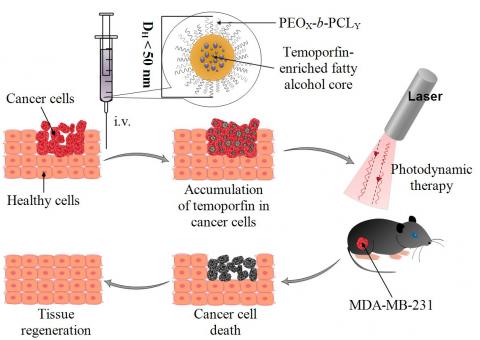Photoactivatable nanoparticles for photodynamic and phototermal applications, method of preparation thereof, pharmaceutical compositions containing them, and use thereof
INTRODUCTION:
The present invention provides polymer surfactant-stabilized thermoresponsive solid lipid nanoparticles with photosensitizer temoporfin (T-SLNP). The efficacy of T-SLNP was compared with commercial temoporfin formulation in terms of in vitro phototoxicity in 4T1 and MDA-MB-231cells and of in vivo anticancer effect in Nu/Nu mice bearing tumors.
TECHNOLOGY (INVENTION) DESCRIPTION:
The present invention provides fully biodegradable/metabolizable formulation of photoactivatable nanoparticles as well as their method of preparation, for photodynamic applications with minimum side effects. It is based on solid lipid nanoparticles (SLNPs) of the photosensitizer and fatty alcohols, whereas the surface of these SLNPs are stabilized with a non-toxic surface active polymer, which prevents entrapping of SNLPs to reticuloendothelial system. The size of the nanoparticle is below 50 nm, and the core of the nanoparticle is solid at the temperature of 4 °C, and liquid at the temperature of 39 °C. The present invention further relates to a method of preparation of the photoactivatable nanoparticle, a pharmaceutical composition containing it, and use thereof.
ADVANTAGES OVER EXISTING SOLUTIONS:
Formulations on the basis of solid lipid nanoparticles provide generally higher bioavailability and a higher therapeutic effect in vitro and in vivo in comparison with commercial temoporfin formulations, especially for use in intravenous drug application form. Owing to controlled and sustained release properties, subcellular size, biocompatibility with tissue and cells, the nanodispersion represents promising drug delivery system applicable in anticancer photodynamic treatment.
DEVELOPMENT STATUS (STAGE):
Nu/Nu mice bearing MDA-MB-231 tumors. Anticancer efficacy was improved compared with commercial temoporfin formulation.
PUBLICATIONS:
US5250236; WO 1993005768 A1; US20080090803 A1; US20060127471 A1; US7354599 B2; US8709449 B2; US20080311214 A1; WO 2010112749 A1; WO 2011116963 A2; US5785976 A; US4880634 A; PCT/EP2012/055222 (WO 2012/127037); US 2015/0273084 A1; Xingwang Zhang, Huan Wang, Tianpeng Zhang, Xiaotong Zhou, Baojian Wu, European Journal of Pharmaceutical Sciences 62 (2014) 301–308; Jingxin Gou, Shuangshuang Feng, Helin Xu, Guihua Fang, Yanhui Chao, Yu Zhang, Hui Xu and Xing Tang, Biomacromolecules 16.9 (2015): 2920-2929, Taratula O., et al., Chemistry of Materials 27.17 (2015):6155-6165.
IP PROTECTION STATUS:
ČR patent with priority ----- granted, PCT in proceeding.
TECHNOLOGY / IP OWNERS :
Ústav makromolekulární chemie AV ČR v.v.i., Heyrovského náměstí 2, 162 06 Prague 6 Vysoká škola chemicko-technologická v Praze, Technická 5, 166 28 Prague 6 – Dejvice

More information
More information is available upon signing a CDA / NDA (Confidential Disclosure Agreement / Non-Disclosure Agreement)